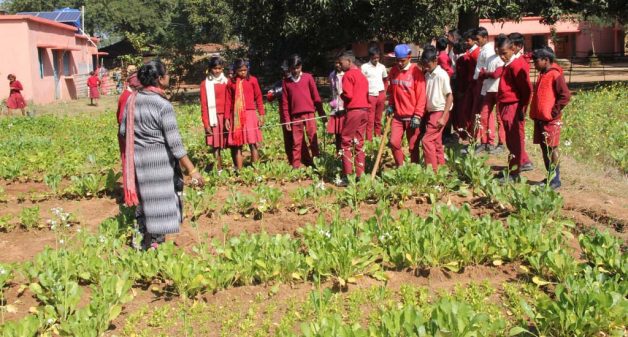The concept of learning through books and scoring high marks through subject knowledge has created barriers in young minds in exploring the outdoors. There is a small reversal in the transition from open air classes to closed door classrooms, in the tribal pockets of Jharkhand.
The state has a diversity of tribal population, its share of conflicts, and a considerable forest cover. The rural population is mainly into farming and farm labor work. They are also dependent on forest produce and common property resources for their livelihood.
Partnering with civil society organizations, the state government introduces innovations to make classrooms more interactive and learning more interesting. Nutrition gardens in schools fulfill this purpose, in addition to improving the nutrition status of students.
Nutrition gardens
In October 2019, Ministry of Human Resource Development issued guidelines to schools, to promote nutrition gardens. The ministry declared that the idea was to make the students be aware of the source of their food and to help them connect with nature.
The vegetables grown in the school premises are to be used in the preparation of the government’s midday meal scheme. In Jharkhand, kitchen gardens in schools are promoted under School and Community based Quality Improvement Program, aimed at education beyond classrooms.
For tribal children who are close to nature, kitchen gardens are a means to stay connected to their culture. The gardens give a homely environment in schools. The students also have the opportunity to practice vegetable cultivation which they learn from their parents.
Creating awareness
Backed by the state government, Collectives for Integrated Livelihood Initiatives (CInI), working among the tribes of central India, started working with government schools to develop nutrition gardens. As a first step, CInI convinced teachers about the need to have nutrition gardens in school.

When they understood the nutritional and academic importance, the teachers readily accepted the idea. Parents and students too understood their roles and responsibilities.
Government school in Dumardaga, Rajkiykrit Utkramit Madhya Vidyalaya in Surunda Godatoli and Rajkiy Buniyadi Vidyalaya, Murhu are some of the schools that are actively participating in the program, and experiencing the benefits.
Community participation
The school management committee (SMC) made up of students and parents, formed with the guidance of teachers and CInI, decides on what to grow, based on the season, soil type, etc. They buy the seeds from the local market.
The dialogues between teachers and parents have been frequent. Involving the community and SMC members in developing and maintaining the gardens has forged a strong relation between the school and the community. SMCs and parents help in preparing the land, fencing, etc.
Vegetables like palak, brinjal, tomato, tinda, methi, bhindi, kudrum, moringa and fruits such as papaya and banana, are some of the commonly grown plants in the school nutrition gardens.
Student cabinets
Baal sansad, meaning student cabinet, is a student group formed by the management and teachers, for students of class 3 onwards. The student cabinet functions like the national one and tries to solve problems in their school.
Taking care of the nutrition garden is one of the responsibilities of the student cabinet. The students are divided into many groups. They have a weekly schedule, with one or two periods allocated for tending to the garden.
The students come up with solutions and innovations to maintain the garden in a sustainable manner. These include using a bicycle to generate energy to operate the sprinklers and drip irrigation systems, installed with the support of CInI. The parents’ farming knowledge helps them handle pests, if any.
Benefits
Through a comic booklet designed by CInI, teachers help the students correlate academics and their nutrition garden. The teachers find that the children are now able to understand various aspects of their subjects, such as calculation of areas in maths, calorie intake in science and the like easily.

The vegetables are used in mid-day meals. Though not sufficient, the effort has changed the students’ eating habits. Gardening has increased their vegetable consumption. This is important since tribal children are used to eating rice with little or no vegetables and pulses, leading to malnutrition and health issues.
The collaborative process involving the community has helped develop a sense of unity, leadership and responsibility among all stakeholders. It has inculcated the habit of team work and cooperation among the students, to nurture their food garden.
Successful model
Due to water scarcity, the nutrition gardens are mostly developed seasonally. Where water is available, kitchen gardens are maintained throughout the year. Today, the nutrition garden initiative is active in 462 government schools in and around Khunti district, benefitting 11,397 students.
Now that the concept of nutrition gardens has found acceptance among teachers, students and parents, and many schools have tasted success, the model can be scaled up to benefit the maximum number of schools in Jharkhand.
Palak Gosai is a researcher at VikasAnvesh Foundation, Pune. Views are personal.








